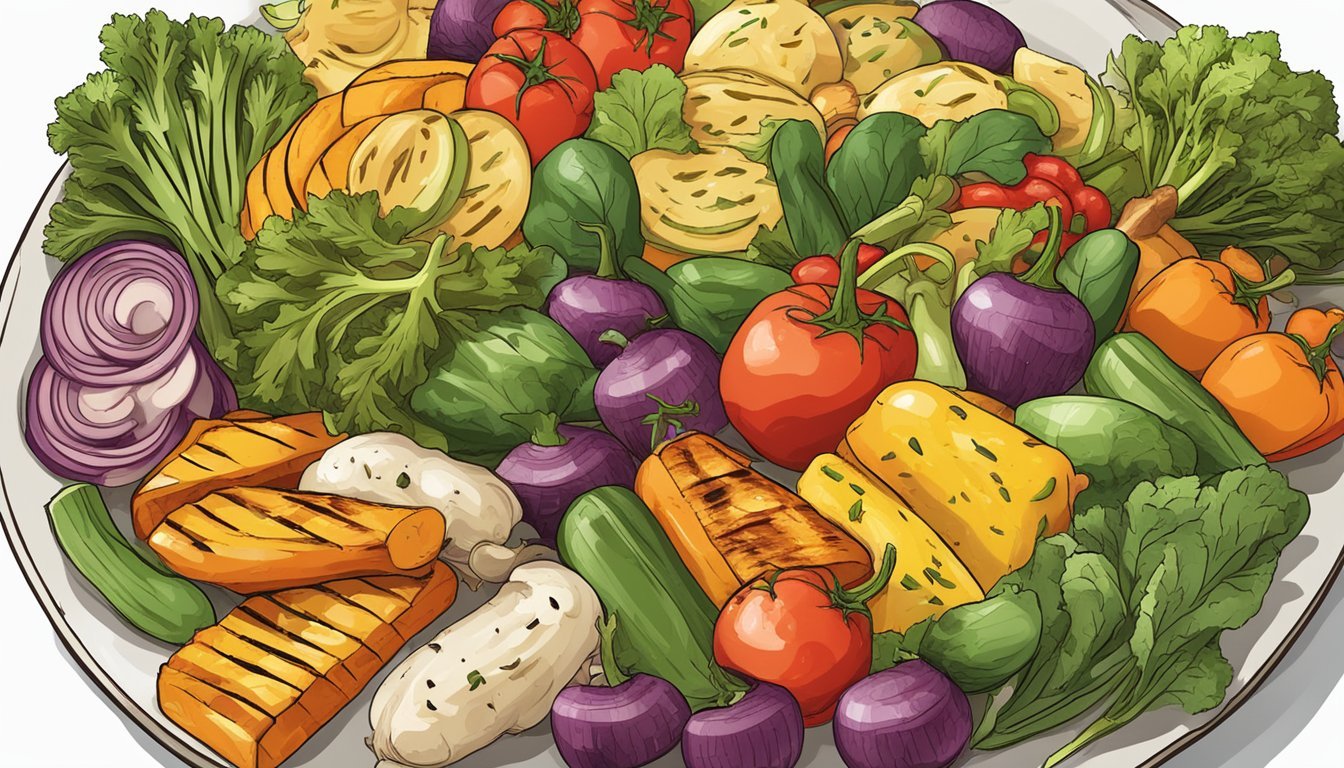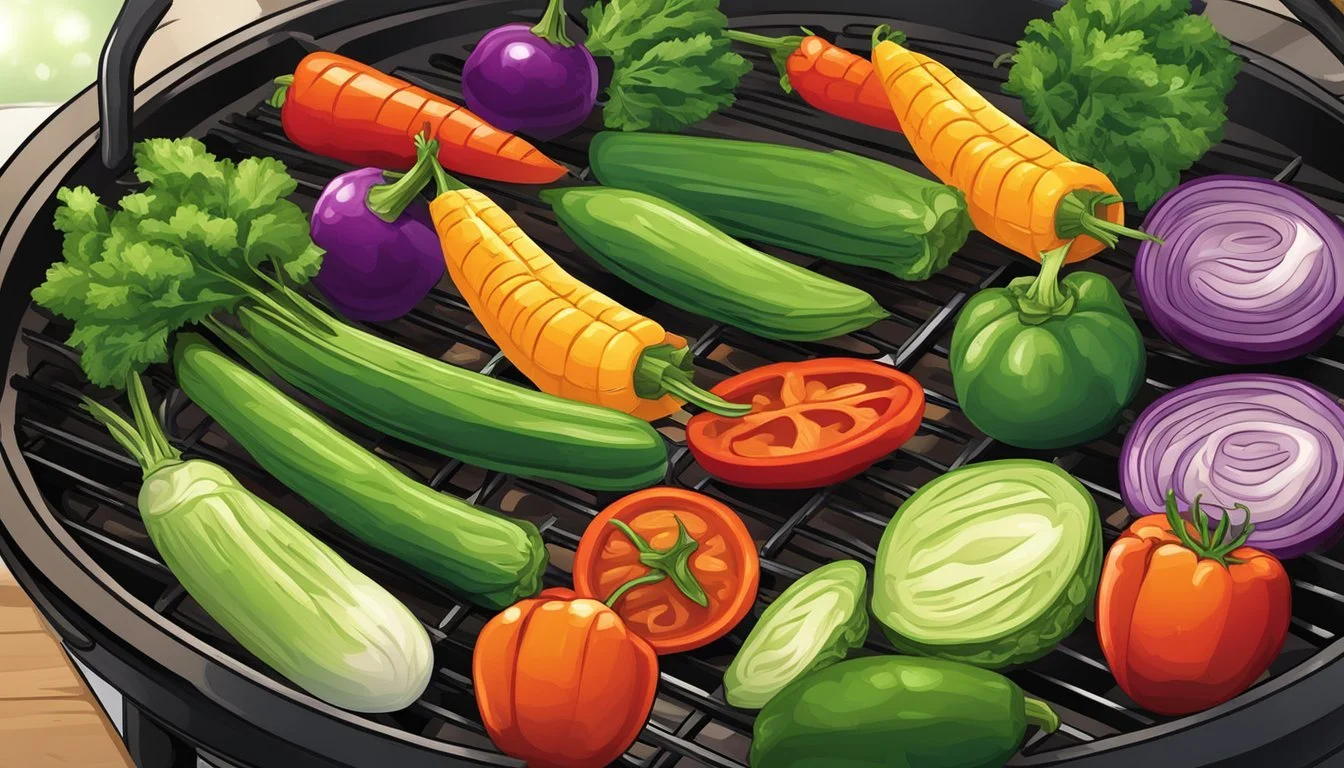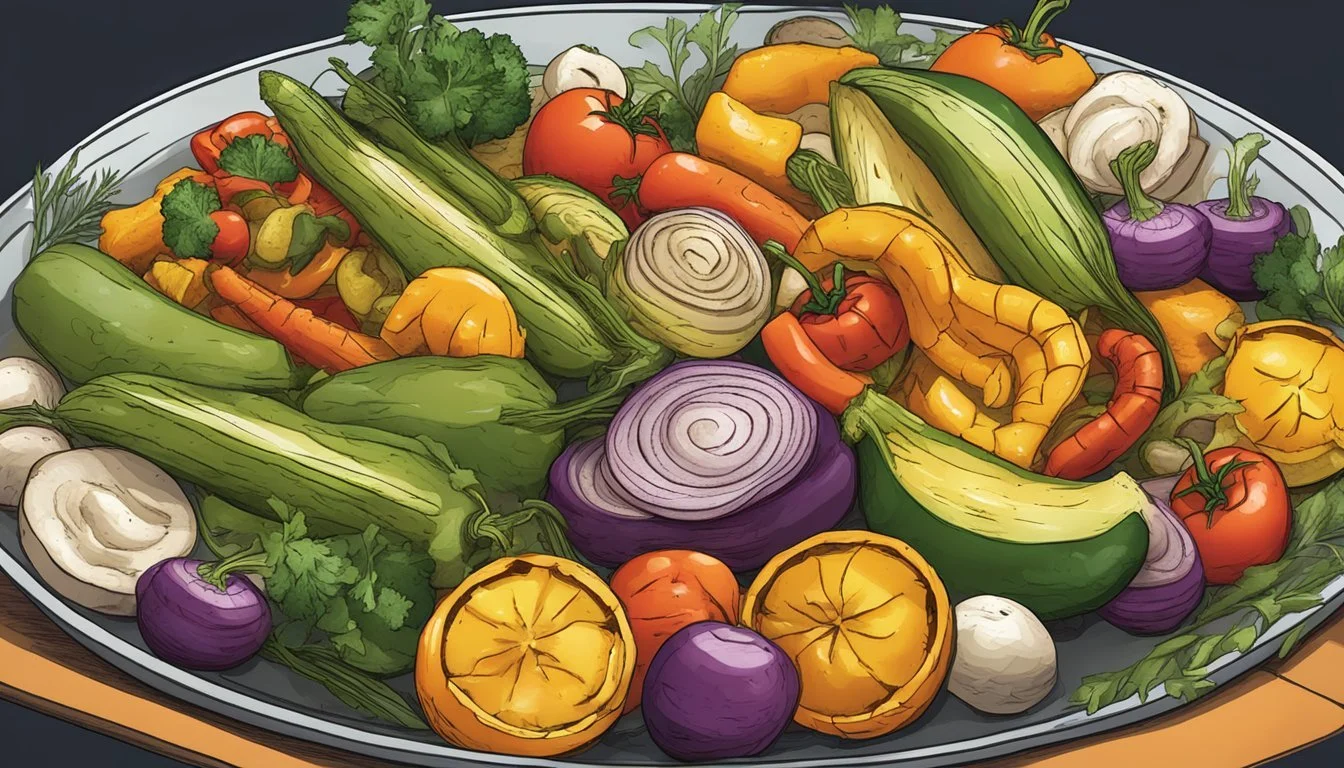How Long Does Gluten-Free Grilled Vegetable Medley Last?
Shelf Life and Storage Tips
How long does a gluten-free grilled vegetable medley last? This question is essential for anyone who enjoys the fresh and flavorful side dish of grilled vegetables.
Prepared correctly, a gluten-free grilled vegetable medley can last in the refrigerator for up to three days. Ensuring the vegetables are properly cooled before storing them in an airtight container will help maintain their freshness and flavor.
Ideal for meal prepping, this delicious and healthy side dish can be conveniently enjoyed throughout the week. Whether paired with grilled meats, fish, or as a standalone snack, keeping a gluten-free vegetable medley on hand can make your meals both nutritious and time-efficient.
Understanding Gluten-Free Cooking
Cooking gluten-free involves understanding the intricacies of avoiding gluten, a protein found in wheat, barley, and rye. This approach offers both health benefits and essential dietary insights.
What Does Gluten-Free Mean?
Gluten-free cooking eliminates any ingredients containing gluten. Wheat, barley, and rye are primary sources. This means avoiding foods like bread, pasta, and certain processed foods unless specifically labeled gluten-free.
Using gluten-free substitutes such as rice, corn, and gluten-free oats is crucial. Cross-contamination is a significant concern, so separate utensils and cooking areas are essential. Labels must be checked meticulously to avoid hidden gluten in sauces and additives.
Benefits of a Gluten-Free Diet
A gluten-free diet is essential for individuals with celiac disease and gluten sensitivity. It alleviates symptoms like bloating, diarrhea, and abdominal pain. They may also help with non-celiac gluten sensitivity, leading to improved digestive health.
Some adopt this diet for broader health reasons, aiming for more natural, less processed foods. By focusing on fruits, vegetables, and lean proteins, individuals often find themselves eating healthier, nutrient-rich meals. While specific to those needing to avoid gluten, the diet's balanced approach can contribute to overall wellness.
Ingredients for Grilled Vegetable Medley
Selecting the right ingredients is crucial for preparing a flavorful gluten-free grilled vegetable medley. Focus on choosing fresh vegetables, high-quality oils and seasonings, and aromatic herbs and spices for the best results.
Choosing Vegetables
Opt for a diverse range of vegetables to add color and texture. Key choices include:
Zucchini: Provides a tender texture when grilled.
Bell Peppers: Red, yellow, and orange varieties add sweetness and a vibrant appearance.
Red Onion: Offers a mild, sweet flavor that mellows when grilled.
Summer Squash: Similar to zucchini, with a slightly firmer texture.
Asparagus: Adds a slightly crispy texture and unique flavor.
Mushrooms: Cremini or button mushrooms absorb marinades well and provide a meaty texture.
Ensure vegetables are cut into uniform sizes for even grilling.
Selecting Oils and Seasonings
High-quality oils and a variety of seasonings enhance the flavor of grilled vegetables.
Olive Oil: A staple for grilling, it adds a rich flavor and helps prevent sticking.
Soy Sauce: For those who are gluten-tolerant, adds a savory depth.
Balsamic Vinegar: A small splash can brighten the dish.
Sea Salt and Black Pepper: Essential for seasoning, they enhance the natural flavors.
Garlic: Minced garlic adds a robust, aromatic quality.
Mix these ingredients in a bowl to create a marinade that coats the vegetables evenly.
Herbs and Spices for Enhanced Flavor
Herbs and spices can transform a simple vegetable medley into a gourmet dish.
Fresh Parsley: Adds a fresh, slightly peppery flavor.
Thyme: Offers a subtle, earthy taste that complements grilled vegetables.
Lemon: A few spritzes of lemon juice can add a refreshing tang.
Onion and Garlic Powders: Provide a concentrated flavor boost without the bulk.
Paprika or Chili Flakes: For a hint of smoky or spicy flavor.
Sprinkling these herbs and spices over the vegetables before grilling will elevate the taste profile.
Preparation Techniques
Effective preparation techniques can significantly enhance the flavor and texture of a gluten-free grilled vegetable medley. Focusing on precise cutting and proper marinating ensures every ingredient is well-seasoned and cooked to perfection.
Cutting and Dicing
Start by choosing fresh vegetables like zucchini, yellow squash, red onion, and bell peppers. Wash thoroughly under cold water. Use a sharp knife to cut zucchini and yellow squash into 1/2-inch lengthwise slices. Red onions should be cut into 1/2-inch rounds.
Uniform cuts are vital for even cooking. Trim the top third of the artichokes and peel outer layers away. Remove stems and additional tough layers. Consistent sizes prevent some pieces from overcooking while others remain underdone. Prep time is typically around 10-15 minutes.
Marinating Vegetables
In a mixing bowl, combine olive oil, minced garlic, balsamic vinegar, and season with salt and pepper. You can also add avocado oil for extra richness. Whisk together until well blended.
Place the cut vegetables in a large bowl or a big zip-lock bag and pour the marinade over them, ensuring every piece is well-coated. You can add spices like garlic powder, onion powder, and Italian seasoning for enhanced flavor. Let the vegetables sit in the marinade for about 10-15 minutes to absorb the flavors.
Grilling the Vegetables
Grilling vegetables to perfection involves using the right equipment, achieving attractive grill marks, and understanding the correct grilling times and techniques.
Using the Right Equipment
Choosing the right equipment can significantly improve the results. A grill pan is ideal for grilling smaller or finely chopped vegetables, preventing them from falling into the grill. For larger pieces, directly placing them on the grill grates works best. Aluminum foil can be used to create packets for vegetables that might need a gentler cooking method, maintaining their moisture. Tongs are essential for flipping and moving the vegetables around without damaging them.
Achieving Perfect Grill Marks
Perfect grill marks are not just visually appealing but also indicate a well-grilled vegetable. The key is to preheat the grill to a high temperature, usually around 400 to 450° Fahrenheit. Placing the vegetables on the grill at an angle and allowing them to sear for a couple of minutes before rotating them will help. Avoid frequent flipping, which can prevent the marks from forming properly. Utilizing a grill pan can also help in achieving even grill marks while keeping the vegetables intact.
Grilling Times and Techniques
Different vegetables require different grilling times. Here's a brief guide:
Vegetable Cook Time (Minutes) Technique Bell Peppers 6-8 Cut into strips, grill directly on grates. Zucchini 4-5 Sliced lengthwise, grill directly or on pan. Mushrooms 5-6 Whole or halved, grill on pan or foil. Eggplant 5-7 Sliced, grill directly or on pan.
It's important to coat the vegetables with a light layer of oil and seasoning before grilling. This not only enhances flavor but also prevents sticking. Cook the vegetables until they are tender and slightly charred, flipping them halfway through the estimated cook time.
Serving Suggestions
When serving a gluten-free grilled vegetable medley, consider complementary flavors and textures to enhance the dining experience. Pairing with proteins and incorporating cheeses can create a balanced meal, while deciding between using it as a side or main course will depend on the occasion and dietary preferences.
Pairing with Proteins
Grilled vegetables go exceptionally well with a variety of proteins. Steak is a classic choice, especially when grilled to medium-rare, offering a robust contrast to the smoky vegetables. Chicken is another excellent pairing, particularly when marinated in herbs and lemon juice to complement the vegetables' flavors. For a lighter alternative, consider grilled fish like salmon or halibut, which provides a tender, flaky option that pairs well with the medley’s freshness.
Incorporating Cheeses
Adding cheeses can elevate the taste of the vegetable medley. Parmesan cheese, freshly grated over the warm vegetables just before serving, offers a nutty and slightly salty flavor. Mozzarella balls can be mixed in to add a creamy texture. For a bolder choice, try feta cheese, which brings a tangy profile that contrasts nicely with the sweetness of grilled vegetables like bell peppers and zucchini.
Side or Main Course
Deciding whether to serve the grilled vegetable medley as a side or main course depends on the meal's context. As a side dish, it complements hearty mains like steak and chicken, adding variety and freshness. To make it a main course, consider bulking it up with additional elements like quinoa or chickpeas for added protein and sustenance. Simply toss the grilled vegetables with the chosen grains and legumes, drizzle with a bit more olive oil and balsamic vinegar, and serve warm or at room temperature.
Storage and Shelf Life
Proper storage can greatly extend the shelf life of a gluten-free grilled vegetable medley. Key considerations include optimal refrigeration methods and techniques for reheating without compromising texture.
Refrigeration and Preservation
To store the gluten-free grilled vegetable medley, use airtight containers to keep out moisture and other contaminants. Ideally, the vegetables should be placed in shallow containers to allow for even cooling and to maintain their texture.
Refrigerate the grilled vegetables at a temperature below 40°F (4°C). The leftovers can last for about 3 to 5 days when stored correctly. Labeling containers with the storage date can help track the total time they have been refrigerated. Reduced sodium and sugar levels in the original recipe can also minimize spoilage risks.
For added preservation, consider using a vacuum sealer. This can help extend the freshness by removing most of the air, slowing down oxidation and bacterial growth. If you notice any off smells or textures, it’s best to discard the vegetables to avoid the risk of foodborne illness.
Reheating Without Losing Texture
Reheating the gluten-free grilled vegetable medley requires a careful approach to maintain its texture and taste. For best results, avoid microwave reheating, which can make vegetables mushy. Instead, reheat in an oven preheated to 350°F (175°C).
Spread the vegetables in a single layer on a baking sheet to ensure even heating. Depending on the quantity, the reheating process should take approximately 10-15 minutes. Stirring halfway through can help achieve uniform warmth.
For a quicker option, use a stovetop skillet with a bit of olive oil. Heat the vegetables over medium heat, stirring frequently for about 5-7 minutes until heated through. This method helps retain the original grilled texture while enhancing flavors.
By following these specific storage and reheating methods, the gluten-free grilled vegetable medley can be enjoyed with quality maintained for several days.
Nutritional Information
A gluten-free grilled vegetable medley offers a range of essential nutrients without compromising healthy eating habits. This section breaks down the caloric content and key macronutrients, providing detailed insights into their nutritional impact.
Caloric Content
A serving of gluten-free grilled vegetable medley typically contains approximately 50-100 calories per cup. This can vary based on the type and amount of vegetables used, as well as any seasonings or marinades included. Common vegetables like zucchini, yellow squash, and red onions contribute to this count.
Grilling vegetables often requires minimal added fats, helping keep calorie counts relatively low. This makes grilled vegetable medleys a suitable option for those monitoring their calorie intake while still seeking flavorful dishes.
Macronutrients and Fiber
Gluten-free grilled vegetable medleys are rich in essential macronutrients. Carbohydrates primarily come from the natural sugars and fibers in vegetables. A cup of this medley can provide about 10-15 grams of carbohydrates, with a significant portion being dietary fiber.
Fiber content ranges from 2-4 grams per serving. This promotes healthy digestion and helps maintain satiety.
Protein levels are generally lower, around 2-3 grams per cup, depending on the vegetables included. Still, these dishes complement protein-rich main courses well.
Fats remain minimal, especially if vegetables are grilled with light oil or no oil at all. Even with a balsamic marinade, fat content remains low, contributing to the dish's healthfulness.
Recipe Variations
Adjusting the recipe for a gluten-free grilled vegetable medley allows for a wide range of flavors. By selecting different vegetables and making seasonal adjustments, you can enjoy this dish all year round.
Vegetable Selections
Choosing the right vegetables can significantly impact the flavor and texture of your gluten-free grilled vegetable medley. Popular options include summer squash, yellow squash, and various types of bell peppers such as yellow and orange.
Green beans and cherry tomatoes also add freshness and color. Each vegetable should be cut into uniform sizes to ensure even cooking on the grill. Mixing vegetables with different textures, like the crispness of bell peppers and the tenderness of summer squash, creates a more interesting dish.
Seasonal Adjustments
Incorporating seasonal vegetables is crucial for both freshness and availability. During summer, opt for vegetables like zucchini, summer squash, and bell peppers, which are at their peak during this time.
In fall, you can substitute with heartier options such as butternut squash or brussels sprouts. Winter might call for root vegetables like carrots and parsnips, while spring could invite asparagus and snap peas.
Adjusting the marinade to complement these seasonal vegetables can enhance the overall taste. For example, a lemon and herb marinade is ideal for spring, while a balsamic glaze suits the robustness of winter vegetables.
Conclusion
Gluten-free grilled vegetable medley typically lasts 3 to 5 days when stored properly.
For best results, store the medley in an airtight container in the refrigerator.
To extend its shelf life, consider freezing portions in freezer-safe bags or containers.
When reheating, ensure the vegetables are heated thoroughly to maintain texture and flavor.
Proper storage and handling are key to keeping the medley fresh and delicious.











